SGI-STL和Nginx内存池剖析
内容
内存池是为了更高效地管理小块内存的频繁开辟、释放。
C++STL:标准模板库。- SGI STL:第三方厂商开发的,后来被纳入
C++标准,成为了C++STL中管理内存的底层实现。 - Nginx内存池设计
C++ STL空间配置器
先用vector举个例子
1 | template<typename T, typename _Alloc = allocator<T>> |
可以看到,vector第二个模板参数是一个空间配置器。
主要包含了四个方法:
allocate:负责给容器开辟内存空间=>mallocdeallocate:负责释放容器内存空间=>freeconstruct:负责在容器中构造对象=>定位new:是基于已经开辟好了的容器空间中直接构造的。destroy:负责析构容器中的对象=>p->~T()
空间配置器的核心作用:
- 拆开了new的两个操作——对象的内存开辟、对象构造;
- 拆开了delete的两个操作——对象的析构,内存的内存释放。
把空间和对象本身分开,在容器这个场景下更为适合。
SGI STL 的两级 allocator
提供了两个allocator的实现:
- 一级allocator,实际上就是
malloc/free; - 二级allocator,是基于内存池的内存管理。
本文主要剖析SGI的二级allocator,即内存池的实现。
通过阅读源码,发现:
SGI STL底层对于容器的对象的构造、析构是通过自定义的全局模板函数Construct和Destroy完成的。
而点进去发现本质上仍是通过定位new、调用对象的析构函数完成的。这些都是内存申请、释放工作之外的动作。
因此,可以推断,SGI STL的空间配置器主要工作的区别在于 allocate 和 deallocate,即对容器内存申请、释放的管理。
SGI STL 内存池的实现
内存池的粒度信息
1 | enum { _ALIGN = 8 }; |
每一个内存chunk块的头信息
1 | union _Obj |
组织所有自由链表的指针数组。
这是静态变量,多线程共享,volatile避免了读取缓存的脏数据。
1 | static _Obj* __STL_VOLATILE _S_free_list[_NFREELISTS]; |
图示:

一个数组,第 1 个位置存放的是 8 字节的内存池,第 2 个位置存放的是 16 字节的内存池,…,最后一个位置存放的是 128 字节的内存池。数组的大小和每个位置对应的字节数由内存池的粒度信息决定。
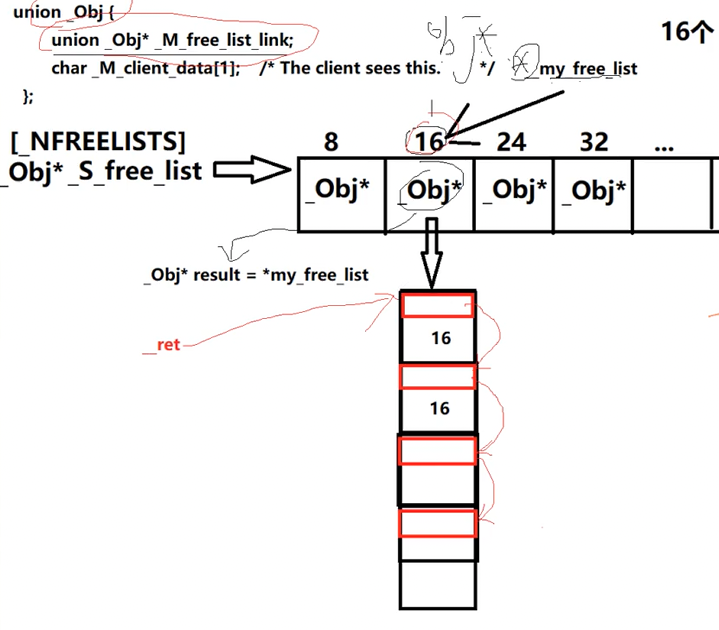
allocate(size_t)
定义在stl_alloc.h中
统一的allocate接口。外部申请 n 个字节。如果是大块内存,则普通malloc。
如果是128字节及以下的内存,则会从内存池中分配,这就是二级空间配置。
1 | static void* allocate(size_t __n) |
_S_freelist_index(size_t)
用于返回freelist的下标,0下标存放的是8字节的内存池块。1下标存放的是16字节的内存池块。以此类推。
比如,
外部申请 1 字节,则
外部申请 7 字节,则
外部申请 8 字节,则
外部申请 9 字节,则
1 | static size_t _S_freelist_index(size_t __bytes) |
_S_round_up(size_t)
外部申请 n 字节,返回的是 n 字节对应的在内存池块中,一小块的实际大小(8的整数倍)。
类似于向上取整(取8的整倍数的最小值),比如输入1到8,输出8。输入9到16,输出16。(输入0,输出0)
比如,
外部申请 1 字节,则
外部申请 7 字节,则
外部申请 8 字节,则
外部申请 9 字节,则
1 | static size_t |
_S_refill(size_t)
调用_S_chunk_alloc(__n, __nobjs),在内存池块中尽量找一个合适的小字节块。
_S_chunk_alloc内部会帮你处理底层的开辟内存池,处理内存碎片,管理内存池的指示信息等等。
由于_S_chunk_alloc第二个参数__nobjs传入的是引用,有可能__nobjs会被改变。
调用之前,__nobjs是我们想要申请的小字节块的个数。
调用结束后,__nobjs更新为了实际分配到的小字节块的个数。
如果是 1 ,此次分配完之后,这个内存池块正好用完了,不构建freelist下标的链表。
其他情况,构建相应的freelist下标的链表。
for循环中做的是遍历内存池大块中的每个单元小块,联合体_Obj*的_M_free_list_link指向紧挨着的下一个单元小块。
1 | /* Returns an object of size __n, and optionally adds to size __n free list.*/ |
图示:

_S_chunk_alloc(size_t, int& nobjs)
在内存池块中尽量找一个合适的小字节块。
期间,可能会改变外部传入的__nobjs。(因为是引用,外部会受影响)
__total_bytes记录的是欲开辟的内存池大小(根据__nobjs,这个是小字节块数)。
__bytes_left指的是_S_end_free - _S_start_free,指目前未被开发的大小。
__bytes_left还足够,返回,无需开辟新空间
如果__bytes_left还足够(至少是 1 个小字节块),则返回_S_start_free。同时移动_S_start_free到新的位置。
成功返回。无需额外操作。
__bytes_left不足,开辟新的更大的内存池块
如果__bytes_left不足,则将要开辟新的更大的内存池块。__bytes_to_get = 2 * __total_bytes + _S_round_up(_S_heap_size >> 4)
__bytes_left > 0,头插到合适的一个链表,管理这个内存碎片
如果__bytes_left > 0。这时,为了不浪费__bytes_left而造成内存碎片,把这部分尚余的小内存给其对应的freelist下标的链头插。比如,剩余 32 字节,则找下标 3 ,头插进去。(见下文图示)
开辟新的大块内存_malloc正常
以下是__bytes_left不足时,都需要做的操作,目的是开辟新的大块内存。返回的地址赋给_S_start_free。
如果malloc正常(malloc返回 != 0),更新_S_heap_size += __bytes_to_get;,更新_S_end_free = _S_start_free + __bytes_to_get;。
malloc成功,递归调用return(_S_chunk_alloc(__size, __nobjs));。
开辟新的大块内存_malloc失败:找内存池中已开辟的大单元链表的空间
如果malloc失败(malloc返回 == 0)。则处理:
遍历freelist的下标各个内存池块。从size_t __n对应的freelist下标,依次往后找有没有还有空闲的。
__i初始化为__n,循环,每次__i += (size_t) _ALIGN(即加8)。比如,__n等于 40 字节,我们依次去找40、48、56等等的freelist下标的内存池块,看看有没有能分配出来空间的。
如果有,则_S_start_free指向第一个空闲块。更新_S_end_free = _S_start_free + __i;
好了,成功在更大单元的内存池块找到,递归调用return(_S_chunk_alloc(__size, __nobjs));。
开辟新的大块内存_malloc失败:异常处理
如果以上的for循环找了后面更大单元的内存池块,仍没有可用空间,则是系统内存不足的迹象:
需要调用malloc_alloc::allocate(__bytes_to_get);。
内部最后一次进行普通malloc的挣扎。
如果malloc仍然返回 0 ,则进行异常处理(绑定的回调)。
1 | /* We allocate memory in large chunks in order to avoid fragmenting */ |
头插小内存碎片,图示
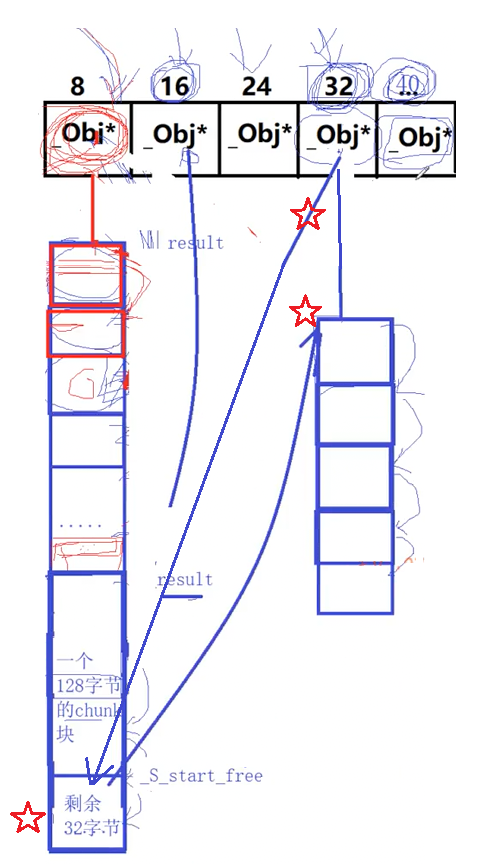
oom异常处理
1 | template <int __inst> |
1 | template <int __inst> |
_S_start_free、_S_end_free、_S_heap_size
这三个变量,只会在_S_chunk_alloc(size_t, int&)函数执行中改变。
1 | template <bool __threads, int __inst> |
deallocate(void* p, size_t)
定义于stl_alloc.h
头插归还,看图示。
1 | template <bool threads, int inst> |
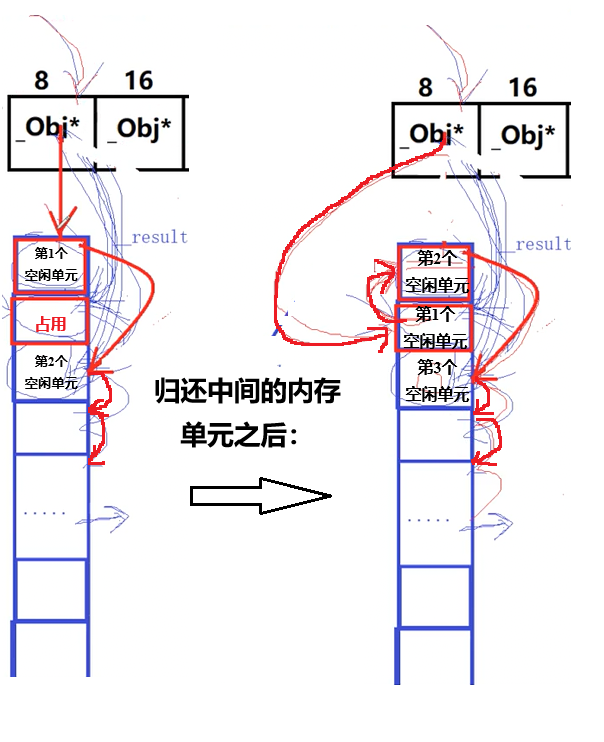
reallocate(void* p, old_sz, new_sz)
对已开辟的内存池块的扩容、缩容。
1 | template <bool threads, int inst> |
SGI STL内存池总结
SGI STL 二级空间配置器内存池的实现优点:
- 对于每一个字节数的chunk块分配,都是给出一部分进行使用,另一部分作为备用,这个备用可以给当前字节数使用,也可以给其它字节数使用
- 对于备用内存池划分完chunk块以后,如果还有剩余的很小的内存块,再次分配的时候,会把这些小的内存块再次分配出去,备用内存池使用的干干净净!防止小块内存频繁的分配,释放,造成内存很多的碎片出来,内存没有更多的连续的大内存块。所以应用对于小块内存的操作,一般都会使用内存池来进行管理。
- malloc内存分配失败,还会调用
oom_malloc这么一个预先设置好的以后的回调函数,如果没设置,则throw bad_alloc。设置了则for(;;)(*oom_malloc_handler)();。
Nginx内存池设计和实现
区分大小内存块的申请和释放,大于池尺寸的定义为大内存块,使用单独的大内存块链表保存,即时分配和释放;小于等于池尺寸的定义为小内存块,直接从预先分配的内存块中提取,不够就扩充池中的内存,在生命周期内对小块内存不做释放,直到最后统一销毁。
Nginx内存池结构图
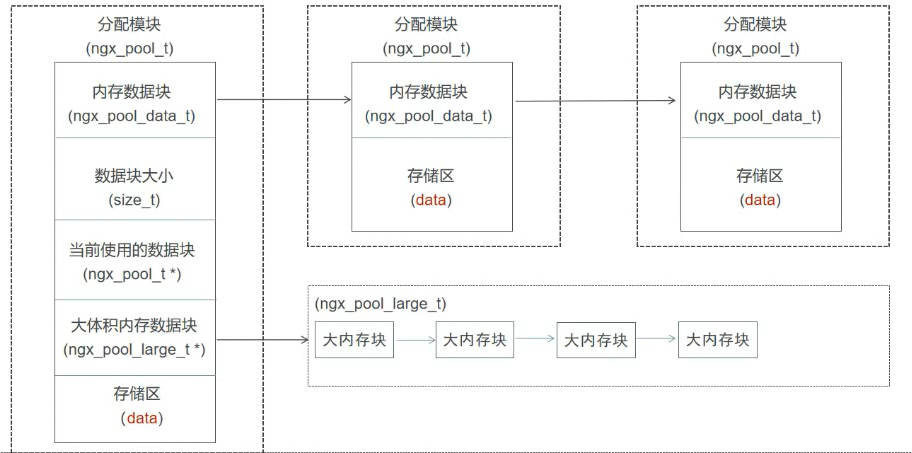
Nginx源码
本次分析的是Nginx-release-1.13.1的源码。
src目录下,有好多模块,其中内存池的模块位于/src/core目录下。使用的是C语言。
对于不同的操作系统,有不同的实现,位于/src/os/unix和/src/os/win32下。
指标
1 | // 位于 ngx_palloc.h |
NGX_MAX_ALLOC_FROM_POOL定义了可以从内存池中申请的最大内存。默认是Nginx页面大小减1。x86系统下是4096字节减1。NGX_DEFAULT_POOL_SIZE定义了Nginx内存池默认大小。是16 * 1024B即16KB。NGX_POOL_ALIGNMENT,内存池,分配内存时的对齐大小。默认是16。NGX_MIN_POOL_SIZE定义了内存池的最小大小。- 其需要通过
ngx_align计算,定义如下:发现和STL的round_up一样,向上取 d 的整 a 倍数。比如,a等于16、d等于7的话,那d取整后就是16,d等于17的话,取整后就是32。 - 其中d是
(sizeof(ngx_pool_t) + 2 * sizeof(ngx_pool_large_t))。a是NGX_POOL_ALIGNMENT,默认是16。
- 其需要通过
1 | // 位于 ngx_config.h |
关键数据结构
定义于ngx_palloc.h
1 | typdef strcut |
在ngx_core.h中,
1 | typedef struct ngx_pool_s ngx_pool_t; |
即npx_pool_t是struct ngx_pool_s的别名。
在Nginx内存池中,npx_pool_t这个结构只出现在第一个内存池块的头部上,后续链接的内存池块头部只有ngx_pool_data_t。
struct ngx_pool_s(别名ngx_pool_t)结构示意图(大小为1024的池)
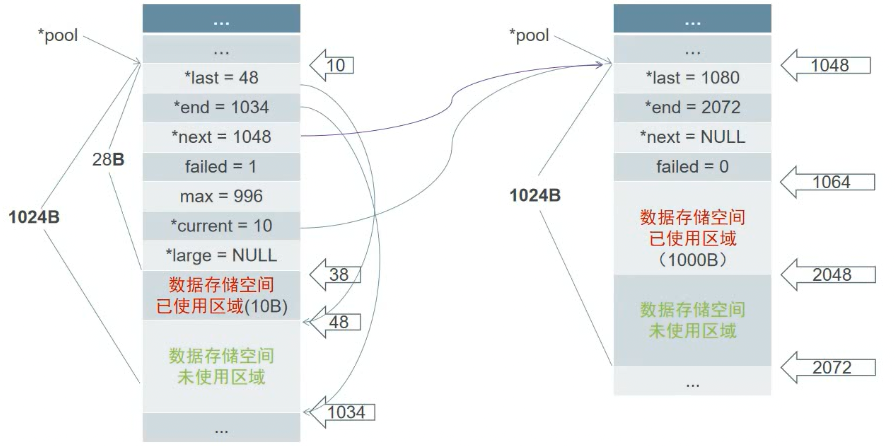
npx_create_pool创建内存池
声明于ngx_palloc.h,定义于ngx_palloc.c。
1 | ngx_pool_t * ngx_create_pool(size_t size, ngx_log_t *log); |
返回npx_pool_t *。
开辟指定大小的内存池。根据不同系统、不同的对齐方法,调用不同的API。
一般是普通的malloc。
1 | ngx_pool_t * ngx_create_pool(size_t size, ngx_log_t *log) |
ngx_memalign(POOL_ALIGNMENT, size, log)或ngx_alloc(size, log)
这是个宏定义,定义于/src/os/unix和/src/os/win32下的ngx_alloc.h。
在Unix下,有对齐的区别:如果要做内存对齐,则size_t alignment参数生效,否则忽略对齐参数
1 |
|
在Win32下,没有对齐限制。#define ngx_memalign(alignment, size, log) ngx_alloc(size, log)
名字上,暂时一样。但是相应的ngx_alloc(size, log)函数,在两个操作系统上就是不同的实现了。
我们看Unix的:实际就是套了个普通malloc。然后输出了一些日志信息。
定义于/src/os/unix/ngx_alloc.c
1 | void * ngx_alloc(size_t size, ngx_log_t *log) |
从创建好的内存池中申请内存
定义于ngx_palloc.c
3个接口:ngx_palloc、ngx_pnalloc、ngx_pcalloc
ngx_palloc和ngx_pnalloc的区别在于在申请小块内存时,前者考虑对齐,后者不考虑对齐ngx_pcalloc是调用ngx_palloc,之后的额外操作是清零申请的区域。
ngx_palloc(pool, size)
如果用户申请小于等于pool头信息中max大小的内存,则按小块管理。
1 | void * ngx_palloc(ngx_pool_t *pool, size_t size) |
1 | void * ngx_pnalloc(ngx_pool_t *pool, size_t size) |
1 | void * ngx_pcalloc(ngx_pool_t *pool, size_t size) |
ngx_palloc_small(pool, size, align)
第3个参数是标志位,1表示考虑对齐,0表示不考虑对齐。
找current,即从该内存池大块之中分配内存。
ngx_align_ptr,将p->d.last指向的可用数据地址按NGX_ALIGNMENT对齐到指定数(默认是32)的倍数,比如如果地址是8,则舍弃一部分内存,对齐到32。
1 | static ngx_inline void * |
ngx_align_ptr(p, a)内存对齐
定义于ngx_config.h
如果没有定义NGX_ALIGNMENT,则默认是sizeof(unsigned long),按照32位对齐。这是内存单元对齐。
注意要和
ngx_palloc.h中定义的#define NGX_POOL_ALIGNMENT 16区分。那是内存池对齐。
即向定义的对齐大小(32)向上取整32倍。
操作是:传入的指针地址,加上指针大小32(4字节,32位)减1,和32减1取反后,相与。
比如:传入的指针地址是8:0000 1000(前面补0),则加32减1:0010 1000
0010 0000 - 1 = 0001 1111取反1110 0000(前面补1)。0010 1000和1110 0000相与后:0010 0000,由原先的8,对齐到了32。
1 |
ngx_palloc_block(pool, size)再开辟一大块内存池
从pool的头块找到end - pool的大小,这是内存池每一个大块的大小(包含头信息的大小)
这是为了再开辟一大块内存池做准备。
ngx_memalign和第一次创建内存池一样,如果没有对齐要求,则普通malloc。
1 | static void * |
ngx_palloc_large(pool, size)大块内存分配管理
用户申请比pool->max大的内存时,按大块内存分配管理。
用ngx_alloc分配size大小的内存(和分配内存池块的方法一样)见ngx_memalign(POOL_ALIGNMENT, size, log)或ngx_alloc(size, log)。
遍历找large链的前5个,看是否有large的alloc为空的,直接让alloc指向一开始malloc得到的p。
如果连续找了5个,发现large的alloc都不为空,则跳出循环,不再找了。
这个for循环是为了快速在前5个large中,找到一个之前开辟的,但已经空闲了的大内存块头信息,其alloc管理的大内存块已经释放了,所以为NULL,直接让alloc指向一开始malloc得到的p即可。
如果没有进入循环,说明large一开始就是空的,内存池没有申请过大块内存;或者是找了5个发现large的alloc都不空:执行下面的操作(头插大内存块的头信息到pool的large链):
记录大内存块(large管理)的 头信息ngx_pool_large_t,是按照ngx_palloc_small方法,存放到了内存池块的小块内存中。
ngx_palloc_small返回空说明系统内存不够用了,失败,释放一开始malloc得到的大块内存,返回NULL。
如果正常,则在这个大块内存头信息填写:
alloc,即这个大块内存的地址,为一开始malloc得到的地址。
next,指向pool的large链头,pool的large指向这个新大块内存的头信息。相当于头插!只不过插的是大内存块的头信息。
1 | static void * |
图示:
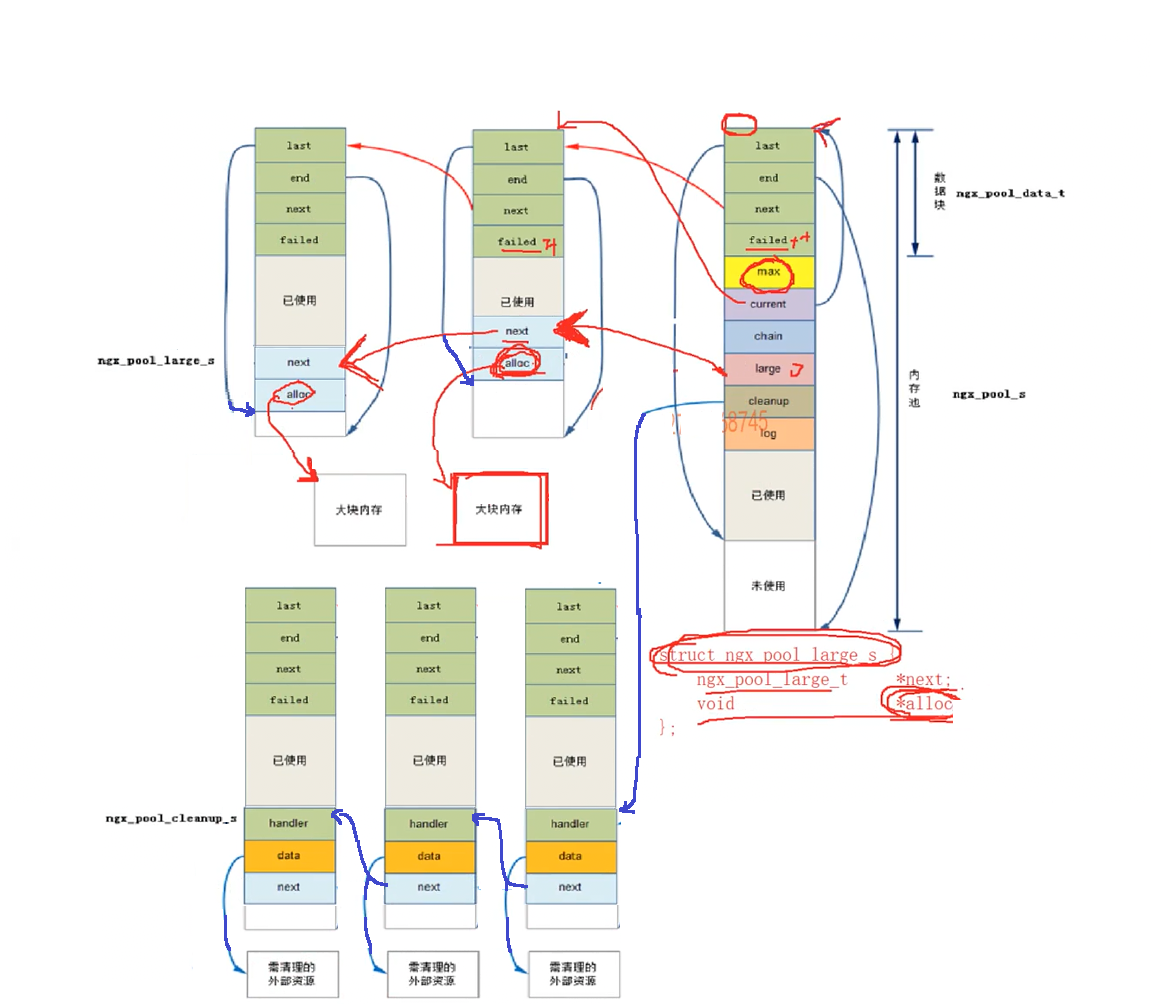
如图,大块内存的头信息,是按小块内存管理,分配到了内存池块中。
下面要提到的外部资源所绑定的清理的头信息,也像是大块内存头信息一样,按小块内存管理,分配到了内存池块中。
ngx_pool_cleanup_add分配一个需要管理外部资源的数据(比如指针、fd)
按小块内存分配ngx_pool_cleanup_t,这是清理的头信息块。
有:handler、data、next。
之后才是分配size。
之后,像头插大内存块的头信息链表一样,头插清理类的头信息链表。
1 | ngx_pool_cleanup_t * ngx_pool_cleanup_add(ngx_pool_t *p, size_t size) |
通过返回的ngx_pool_cleanup_t *绑定清理回调函数
1 | struct Data |
ngx_pfree(pool, void *p)大块内存释放
用于释放大块内存。先free,后把large头信息中的alloc置空。
1 | ngx_int_t |
小块内存释放:无
Nginx的小块内存一旦分配了之后,就无法精确地回收。
不像SGI STL一样,假设A、B、C三个小内存单元相邻,A、C空闲,A是freelist的第一个空闲块,A的next是C。现在释放B,则B头插到freelist,现在是B连着A连着C。这样可以精确地释放,并下次还能重新分配(可以发现,由于是头插到了freelist的第一个空闲区域,所以最后释放的最先分配)。
Nginx呢,每个内存池块只是由last和end两个指针管理,只能指示当前内存池块的未分配的部分。
当已分配的部分中,有 1 个小块内存要释放,无法精确管理。所以Nginx只能连续地释放一整段空间,与last相连。
ngx_reset_pool(pool)
遍历large链表,释放每个大块内存。最后large置空。
遍历每个内存池块,把last拉到头信息的末尾即可,相当于释放了内存池的数据。最后current置为pool。
注意,只是释放了大块内存,所有内存池块都没有free,只是更新了last。
1 | void ngx_reset_pool(ngx_pool_t *pool) |
ngx_destroy_pool(pool)
- 遍历“清理”链表,每个都按照绑定的handler释放其data外部资源。
- 遍历large链表,释放每个大块内存。
- 遍历每个内存池块,释放每个内存池块。
1 | void |
Nginx和STL释放内存的策略适用的场景
Nginx大块内存分配=》内存释放ngx_free函数
Nginx小块内存分配=》没有提供任何的内存释放函数。
实际上,从小块内存的分配方式来看(直接通过last指针偏移来分配内存),根本没法进行中间部分的小块内存的回收。
Nginx本质:HTTP服务器是一个短链接的服务器,客户端(浏览器)发起一个request请求,到达Nginx服务器以后,处理完成,Nginx给客户端返回一个response响应,HTTP服务器就主动断开tcp连接。
假设HTTP 1.1 keep-alive:60s,HTTP服务器(nginx)返回响应以后,需要等待60s,60s之内客户端又发来请求,重置这个时间;
否则60s之内没有客户端发来的响应,Nginx也是最终会主动断开连接,此时Nginx可以调用ngx_reset_pool重置内存池了,等待下一次客户端的请求。
因此,Nginx内存池的设计适用于间歇性、短连接的服务。虽然有内存泄漏,但效率高,空间换时间。
如果是长连接,且小块内存分配、释放较多,最好用STL二级空间配置器,避免内存泄漏过多。